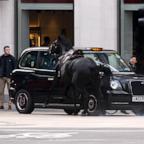A sign of MLB's future? Why the Cubs' 4-man outfield matters
— -- There are only three positions in baseball that have the force of law behind them.
The pitcher really is the pitcher; once he comes into a game, he must face at least one batter before he can be replaced by another pitcher. The catcher really is the catcher; he has to set up in the area behind home plate, and if he's not in that area when the pitch is delivered, the pitcher is charged with a balk. And the first baseman really is the first baseman, as he is the only player allowed to wear a special glove. There are rules about where these guys can stand.
Everything else is just a suggestion. As with Ikea instructions, you're totally free to ignore them and build the thing however you like. It might fall apart, but if you can make it work, there's a Pinterest page waiting to celebrate you.
On Monday, when Joey Votto batted in the fifth inning of the? Cincinnati Reds' 15-5 loss to the Chicago Cubs, opposing manager Joe Maddon decided to go off book. He sent his third baseman Kris Bryant into the outfield:
We might remember this as a freak show moment, a one-time thing that cutesy Maddon tried because isn't he precious. One-time thing or not, though, it should be taken more seriously than that. Baseball is having a serious conversation with itself right now, and this is an important moment in that conversation. Whether Maddon ever employs a four-man outfield again, we might trace something else back to this moment.
We might also wonder, simultaneously, why Maddon tried it here of all times.
Votto is an odd candidate for the treatment. He is not an extreme fly ball or line drive hitter. His fly ball rate (40 percent) is five percentage points above the league overall but trails true fly ball hitters such as? Joey Gallo (58 percent) and Cody Bellinger (49 percent). Despite an ability to go foul pole to foul pole, Votto isn't particularly damaging with his fly balls -- at least, with those that stay in the park. His batting average on fly balls in play over the past four years is only .080, which is roughly the league average. He is not a very fast runner, so there's no extra pressure on outfielders to cut balls off quickly to hold him to a single.
By moving an infielder to the outfield, the Cubs took away the chance to put on an infield shift, and Votto is a hitter against whom the shift has been very effective. Over the past three years he has faced 652 shifts, according to Baseball Info Solutions, and hit 53 points lower against the shift than against a more traditional infield alignment.
Votto was facing Jose Quintana, who is a moderately ground ball-oriented pitcher. Quintana also is a lefty, and Votto is less dangerous against lefties than righties. (Votto had grounded out twice Monday night before the fifth inning.) And for good measure, Wrigley Field isn't even a spacious outfield. By square footage, it's slightly smaller than the median pastures.
Finally, the Cubs were up by five. They were trading a much higher likelihood of a single for a much lower likelihood of extra bases. The score would suggest their priorities should have been otherwise.
I can name four points in favor of the call:
- With one out and nobody on, a single is a little less harmful than usual and a double is a little more harmful than usual, so the base/out state was favorable.
- With a five-run lead, it's a fairly safe time to try something you've always wanted to try.
- It's fun, which isn't something you usually can say about facing Votto. Because ...
- Votto has hit 354/.473/.628 against the Cubs since Maddon took over as manager. At a certain point, a reasonable human is willing to try almost anything.
These are the things you think about when deciding whether it's time for the four-man outfield. I happen to know a bit about it. A couple of summers ago, Ben Lindbergh and I ran baseball operations for an independent minor league team. One of our beliefs was that positions are a social construct; one of our hypotheses was that we could do better. In select spots, we used both a five-man infield and a four-man outfield in regular (that is, non-walk-off) game situations.
The five-man infield was the much scarier call to make. It left a huge part of the field exposed. And if the batter beat the alignment, he wouldn't just get a single (as he would in beating an extreme infield shift), but a triple -- and perhaps even an inside-the-park home run.




